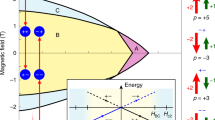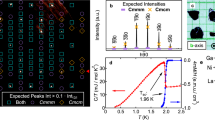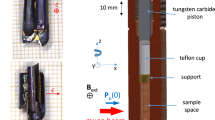Abstract
Arising from: Kaminski, A. et al. Nature 416, 610–613 (2002); Kaminaski et al. reply One of the mysteries of modern condensed-matter physics is the nature of the pseudogap state of the superconducting cuprates. Kaminski et al.1 claim to have observed signatures of time-reversal symmetry breaking in the pseudogap regime in underdoped Bi2Sr2CaCu2O8+δ (Bi2212). Here we argue that the observed circular dichroism is due to the 5×1 superstructure replica of the electronic bands and therefore cannot be considered as evidence for spontaneous time-reversal symmetry breaking in cuprates.
This is a preview of subscription content, access via your institution
Access options
Subscribe to this journal
Receive 51 print issues and online access
$199.00 per year
only $3.90 per issue
Buy this article
- Purchase on Springer Link
- Instant access to full article PDF
Prices may be subject to local taxes which are calculated during checkout

Similar content being viewed by others
References
Kaminski, A. et al. Nature 416, 610–613 (2002).
Borisenko, S. V. et al. Phys. Rev. Lett. 92, 207001 (2004).
Armitage, N. P. & Hu, J. Phil. Mag. Lett. 84, 105–107 (2004).
Kaminski, A. et al. Preprint at 〈http://arXiv.org/cond-mat/0306140〉 (2003).
Author information
Authors and Affiliations
Corresponding author
Rights and permissions
About this article
Cite this article
Borisenko, S., Kordyuk, A., Koitzsch, A. et al. Time-reversal symmetry breaking?. Nature 431, 1–2 (2004). https://doi.org/10.1038/nature02931
Published:
Issue Date:
DOI: https://doi.org/10.1038/nature02931
This article is cited by
-
Time-reversal symmetry breaking? (reply)
Nature (2004)
Comments
By submitting a comment you agree to abide by our Terms and Community Guidelines. If you find something abusive or that does not comply with our terms or guidelines please flag it as inappropriate.



